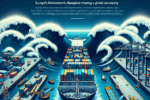New York, United States – Recent global interest rate cuts are causing a stir in financial markets, with central banks around the world taking action to stimulate their respective economies. The Bank of Canada and the European Central Bank both slashed their key interest rates, sparking a wave of rate cuts in other major economies including Brazil, Chile, Mexico, Sweden, and Switzerland. The Bank of England, initially planning a rate cut, may postpone it due to a declared election.
In the United States, the Federal Reserve was poised to follow suit with a rate cut in June, but rising inflation prompted a delay until July or even September. As a result, the U.S. now lags behind Europe in rate cuts, potentially leading to higher rates and increased foreign investment in the U.S. dollar for higher returns.
The effects of these global rate cuts are already being felt in the U.S. Treasury market, with yields on 10-year Treasury bonds fluctuating in response to overseas rate cuts and economic indicators. Despite a recent rise in yields following a strong payroll report, the Federal Reserve may still opt to hold interest rates steady.
On the job front, new reports show a mixed picture with strong job gains in various sectors but a rise in the unemployment rate. The manufacturing industry also faces challenges, with recent data indicating a decline in the manufacturing index, hinting at a continuing recession in the sector.
While the service sector fared better, with an increase in the non-manufacturing index, concerns about consumer spending persist. The disparity between income levels and financial insecurity among certain demographics could have implications for the upcoming Presidential election.
Further complicating the economic landscape is the private credit market, where risks are mounting according to JPMorgan CEO Jamie Dimon. A recent leveraged buyout debacle involving Pluralsight is raising red flags about the sustainability of high yields in the private credit industry and the potential for a market correction.
Amidst these economic challenges, the global geopolitical landscape is also in flux, with escalating tensions in Ukraine and the risk of a proxy war between NATO-backed forces and Russia. The outcome of these conflicts could have far-reaching implications for global stability and economic outlooks.
As investors navigate these uncertainties, staying informed and exercising caution in financial decisions is crucial in adapting to changing market conditions and mitigating risks. In a volatile economic environment, strategic investments and prudent financial management are key to weathering the storm and capitalizing on emerging opportunities.










